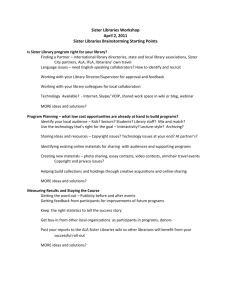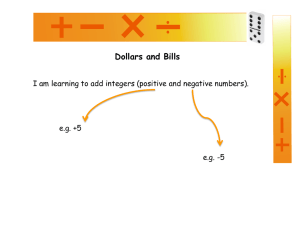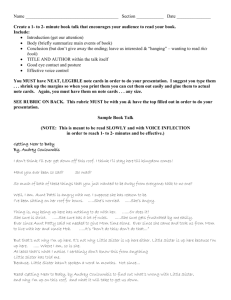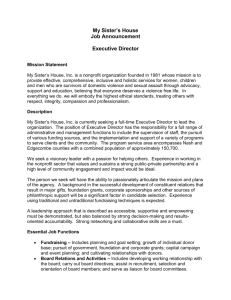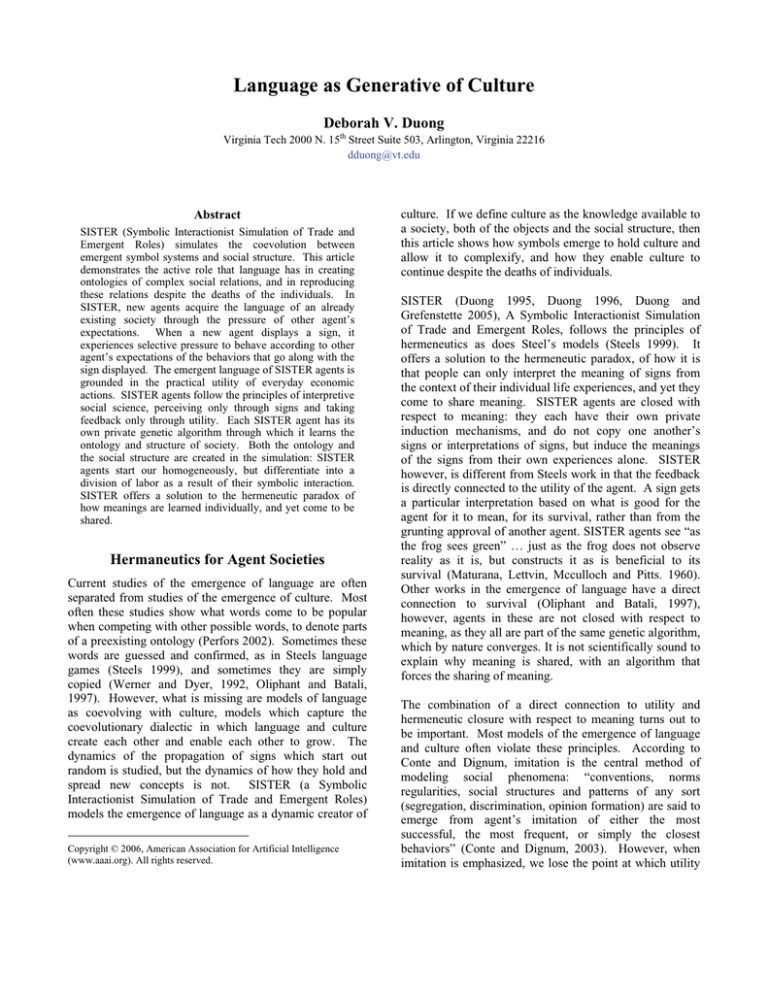
Language as Generative of Culture
Deborah V. Duong
Virginia Tech 2000 N. 15th Street Suite 503, Arlington, Virginia 22216
dduong@vt.edu
Abstract
SISTER (Symbolic Interactionist Simulation of Trade and
Emergent Roles) simulates the coevolution between
emergent symbol systems and social structure. This article
demonstrates the active role that language has in creating
ontologies of complex social relations, and in reproducing
these relations despite the deaths of the individuals. In
SISTER, new agents acquire the language of an already
existing society through the pressure of other agent’s
expectations. When a new agent displays a sign, it
experiences selective pressure to behave according to other
agent’s expectations of the behaviors that go along with the
sign displayed. The emergent language of SISTER agents is
grounded in the practical utility of everyday economic
actions. SISTER agents follow the principles of interpretive
social science, perceiving only through signs and taking
feedback only through utility. Each SISTER agent has its
own private genetic algorithm through which it learns the
ontology and structure of society. Both the ontology and
the social structure are created in the simulation: SISTER
agents start our homogeneously, but differentiate into a
division of labor as a result of their symbolic interaction.
SISTER offers a solution to the hermeneutic paradox of
how meanings are learned individually, and yet come to be
shared.
Hermaneutics for Agent Societies
Current studies of the emergence of language are often
separated from studies of the emergence of culture. Most
often these studies show what words come to be popular
when competing with other possible words, to denote parts
of a preexisting ontology (Perfors 2002). Sometimes these
words are guessed and confirmed, as in Steels language
games (Steels 1999), and sometimes they are simply
copied (Werner and Dyer, 1992, Oliphant and Batali,
1997). However, what is missing are models of language
as coevolving with culture, models which capture the
coevolutionary dialectic in which language and culture
create each other and enable each other to grow. The
dynamics of the propagation of signs which start out
random is studied, but the dynamics of how they hold and
spread new concepts is not. SISTER (a Symbolic
Interactionist Simulation of Trade and Emergent Roles)
models the emergence of language as a dynamic creator of
Copyright © 2006, American Association for Artificial Intelligence
(www.aaai.org). All rights reserved.
culture. If we define culture as the knowledge available to
a society, both of the objects and the social structure, then
this article shows how symbols emerge to hold culture and
allow it to complexify, and how they enable culture to
continue despite the deaths of individuals.
SISTER (Duong 1995, Duong 1996, Duong and
Grefenstette 2005), A Symbolic Interactionist Simulation
of Trade and Emergent Roles, follows the principles of
hermeneutics as does Steel’s models (Steels 1999). It
offers a solution to the hermeneutic paradox, of how it is
that people can only interpret the meaning of signs from
the context of their individual life experiences, and yet they
come to share meaning. SISTER agents are closed with
respect to meaning: they each have their own private
induction mechanisms, and do not copy one another’s
signs or interpretations of signs, but induce the meanings
of the signs from their own experiences alone. SISTER
however, is different from Steels work in that the feedback
is directly connected to the utility of the agent. A sign gets
a particular interpretation based on what is good for the
agent for it to mean, for its survival, rather than from the
grunting approval of another agent. SISTER agents see “as
the frog sees green” … just as the frog does not observe
reality as it is, but constructs it as is beneficial to its
survival (Maturana, Lettvin, Mcculloch and Pitts. 1960).
Other works in the emergence of language have a direct
connection to survival (Oliphant and Batali, 1997),
however, agents in these are not closed with respect to
meaning, as they all are part of the same genetic algorithm,
which by nature converges. It is not scientifically sound to
explain why meaning is shared, with an algorithm that
forces the sharing of meaning.
The combination of a direct connection to utility and
hermeneutic closure with respect to meaning turns out to
be important. Most models of the emergence of language
and culture often violate these principles. According to
Conte and Dignum, imitation is the central method of
modeling social phenomena: “conventions, norms
regularities, social structures and patterns of any sort
(segregation, discrimination, opinion formation) are said to
emerge from agent’s imitation of either the most
successful, the most frequent, or simply the closest
behaviors” (Conte and Dignum, 2003). However, when
imitation is emphasized, we lose the point at which utility
enters the picture. People invent meaning as it makes
sense to their lives: as Piaget said, “to understand is to
invent” (Piaget 1972). In other words, language and
concept acquisition which goes along with it, do not
happen by imitation as much as by making sense in the
context of ones life experiences. If we do not model the
advantage to utility that an interpretation confers at every
step, we lose the ability to model important social
processes of what becomes popular. One example of such
a process is the legend. Legends hold deep cultural
meaning, often so deep as to be universal. Legends are told
and retold orally over many generations. Each time they
are retold, the teller contributes to the creation of the
legend in small ways. As all the authors of a legend
recreate it to meet their needs, it comes to be very good at
meeting needs, settling down on a compromise between all
needs. Imitation without such modification does not
promote cultural products which contribute to the needs of
all, deeply intertwined with the rest of the culture. It is not
a deep consensus.
which means different things for different perceivers of the
sign. A sign is the focal point of a set of social behaviors
in a social network. The signs and the set of relations they
denote are emergent, and must be emergent if they are
going to denote any arbitrary set of behaviors. The
knowledge in the society is held in the expectations that
signs bring to the agent’s mind. These meanings are all
induced by the private inductive mechanisms of agents,
and yet the meanings of the signs come to be shared.
The principles of hermeneutics are important to the study
of the emergence of language because we can not separate
language learning from concept learning, concept creation,
and language creation. If we look at language as a passive
thing, it does not matter if we include utility or not. If all a
word is, is a random sign, and all we are explaining is how
one random sign gets chosen over another random sign,
then we need look no further than imitation. However, if
we look at a word as a holder of a concept, a concept
which serves to meet the needs of people within a web of
other concepts, and which can only emerge as a word to
denote it emerges, then it is appropriate to model the
emergence of words in agents which interpret their
meanings solely from their individual perspectives and
usefulness to their lives. All the interpretations together
create words and concepts which best serve the cultural
needs of all the individuals. In the study of the emergence
of language, it is not the sequence of phonemes that
becomes popular that is important, but rather the capturing
of the dynamic in which words make possible the
ontologies that we use to construct our world. Studies in
the emergence of language should address how words
make the most practical ontologies, through the
contributions of all utterers of words, rather than address
the most practical sounds uttered.
SISTER captures the fundamental social process by which
macro-level roles emerge from micro-level symbolic
interaction. SISTER comprises a multi-agent society in
which agents evolve trade and communication strategies
over time. A rudimentary communication system based on
“tags” or “signs” associated with each agent is a key
component of the model. The knowledge in SISTER is
held culturally, suspended in the mutual expectations
agents have of each other based on the signs (tags) that
they read and display.
Language emerges and is
maintained robustly, despite the stresses of deaths of
individual agents and distance. SISTER shows how a
complex endogenous communication system can develop
to coordinate a complex division of tasking, in which
symbols and roles are maintained despite distance and the
deaths of individual agents.
This paper will show that social systems with an emergent
symbol system denoting an ontology of roles can enable
cultural knowledge to continue despite the deaths of its
individual members. The reason that it can continue is that
signs denoting roles create expectations of behavior,
depending on the individual perceiving the sign. These
expectations have a role in language acquisition: they
serve to train newcomers into the society into the proper
behaviors of the role. Each sign for a role is a contract,
SISTER is a simulation of the basic social process: the
emergence of macro-level social institutions from microlevel symbolic interactionism (Duong and Grefenstette,
2005).
SISTER was the first program to address the
hermeneutic paradox, that people learn only from their
own experiences, and yet share meaning on the social level
(Duong 1995). SISTER outputs a division of labor and
social structure that increases the utility of agents. Agent
ontologies of roles emerge that guide agents in complex
social relations and behaviors needed for survival.
SISTER employs coevolution, in which agents each have
their own genetic algorithm (GA), whose fitness is
dependant on successful interaction with other agents.
These GAs evolve tags that come to indicate a set of
behaviors associated with a role. Figure 1 illustrates
evolved tags indicating agent roles. Roles are nowhere
determined in the simulation and exist in no one place, but
rather are suspended in the mutual expectations of the
coevolving agents. These mutual expectations emerge
endogenously and are expressed through signs with
emergent meanings.
All institutional knowledge is
distributed in these subtle mutual expectations.
Figure 1. Agents that evolve the same tags in their separate GAs
and have the same behaviors are in the same roles.
How SISTER Works
SISTER simulates a differentiation into the roles of a
division of labor in an economic system (Duong, 1996,
2005). In SISTER, initially homogenous agents
differentiate into the heterogeneous agents reflecting a
division of labor. Roles solve the problem of how agents
may work together to increase their utility. Every “day” of
the model, agents harvest goods in the morning according
to their production plans, trade in a market in the afternoon
according to their trade plans, and consume their food at
night, judging a single chromosome of plans for the day by
their satisfaction in consumption (according to a CobbDouglass utility function). Agents are free to devote their
efforts to harvesting goods or trading them. The simple
economic assumption of economy of scale is built in (it is
more efficient to produce a single good than to diversify
production), as is a utility function that rewards
accumulation of multiple goods. These combine to
encourage trade among agents.
SISTER focuses on how agents determine who to trade
with. Agents seek trading partners based on a displayed
sign. Signs are induced both by the wearer, and by the
agent seeking trade. See figure 2 for an example of a trade
plan. This “double induction” of a sign is a simulation of
Parson’s “double contingency” (Parsons, 1951), and
facilitates the emergence of a shared symbol system. Signs
have no meaning in the beginning of the simulation, but
come to have a shared meaning. Agents come to agree on
what a sign implies about behavior. As they come to a
consensus, a system of roles is developed.
Figure 2. Agents must have a corresponding trade plan encoded
in their genetic algorithms for a trace to take place. Each
chromosome has all the plans of trade and production for a single
day, and the plan to display a sign as well (the Passive trader’s
chromosome tells him to display sign 9, in a section that is not
illustrated).
For example, suppose the goods of a simulation run
include berries and milk. Suppose agents coincidently
have the trade plan in figure 2, and each agent benefits
from the trade. Both agents are satisfied with the trade and
the sign: they remember this sign, and repeat it in future
trades. The more the trade is repeated in the presence of
the original sign, the more it becomes a stable element in
the environment and therefore something that other agents
can learn. Since an agent with an active trade plan is
looking for any agent who displays a particular sign, any
agent can get in on the trade just by displaying the
appropriate sign. The agents come to believe that the sign
means “milk,” in the sense that if an agent displays the
sign, then other agents will ask him to sell milk. This puts
selective pressure on that agent to make and sell milk. If a
random agent displays the sign for a composite good (a
good composed of other goods, like “berry-flavored
milk”), it learns the recipe for the composite good from
marketers trying to sell the ingredients for the composite
good.
Over time, the society divides into roles, with
groups of agents displaying the same sign and having the
same behavior.
The signs are Berger and Luckmann’s “objectivations” that
become coercive: if a new agent is inserted into the
simulation, then to participate in trade he must learn the
sign system already present (Berger and Luckman, 1966).
The signs are a guide to his behavior: When he displays a
sign, the other agents pressure him to have the
corresponding behavior. Thus a sign creates expectations
of behavior, in accordance with Parson’s ideas of double
contingency and Luhmann’s model of mutual expectations
(Parsons, 1951; Luhmann, 1984). The mutual expectations
that the agents have of the roles allows individuals to take
advantage of what other individuals have learned in
previous interactions. The knowledge of the society is held
in the mutual expectations of the symbol system, as in
Parsons’ and Luhmann’s theories (Parsons, 1951;
Luhmann, 1984). The reason that role systems can hold
more information about how to make cultural products is
that agents can replace one another and can learn from the
expectations that other agents have of their replacement
class. This is how they become trained to do their role.
However, this training is not inflexible: what they do is
ultimately connected to their utility. They can reject a
trade if it is not to their advantage. Thus SISTER agents
have the flexibility needed to complexify.
Figure 3 illustrates a role based society that is advanced
enough to make composite goods, with a relatively high
mutual information.
Figure 3. A scenarios from SISTER representing the trades made
in a single day of the simulation. Agents with the same color
square have come to have the same role: that is, the same trading
behaviors and same sign. The smaller shapes represent goods
traded. An arc connecting shapes represents a trade. The stars are
composite goods, or goods composed of other goods. Agents
have developed complex roles and composite goods.
Experiment
In this experiment, agents which display induced signs are
compared to a control in which agents are forced to display
a unique ID. The use of an ID prevents the formation of a
system of roles denoted by the induced signs. We refer to
a society where agents read and display signs freely as a
“role recognition treatment” and a society where agents are
forced to display a unique ID as an “individual recognition
treatment.” Whether the sign is arbitrary or an ID, an
agent seeking a trade has to induce the sign to seek in
trade. However, in the role recognition treatment, the
displayer of a sign induces the sign it should display at the
same time that the agent seeking a trade induces the sign to
read. This double induction allows a system of arbitrary
symbols to come to have meaning, but there is no double
induction in the control. Duong and Grefenstette (2005)
contains an experiment where individual recognition is
compared to role recognition in the ability to create
complex goods. The experiment of this article has both
treatments making complex goods, and compares their
ability to make them when there is a complete turnover in
their population as a result of death and rebirth of agents.
Death and birth is added to test the ability of new agents to
acquire the language of the existing agents and achieve
cultural continuity that is greater than the individual
behaviors of members of the culture. The individual
recognition treatment and the role recognition treatment
are run twenty times each.
In this experiment, three different death rates are applied to
each treatment. The average utility of the agents (the
number of goods and the evenness of the spread of the
goods, measured with a Cobb-Douglas utility function) is
compared in each treatment, as well as the mutual
information in the symbol systems that have evolved. The
higher the correspondence between behavior and the sign
displayed, the higher the information content, or mutual
information, in the symbol system. Although the signs of
the individual recognition treatment are not modifiable by
the displayers of the signs, there is still a symbol system
whose information may be measured. The individual
recognition treatment can reach high values of mutual
information if agents displaying different ID’s have
different behaviors. If a treatment has a higher utility
value, then the agents are more successful in trading with
each other. If they have higher mutual information, which
is correlated with that utility, then it is likely that they are
trading better as a result of the information contained in
their symbol systems. Thus language makes knowledge
and culture possible. They develop a language that is
practical for the purposes of setting up networks of trade.
If this language can carry these practical recipes for
interaction on even through a complete turnover of the
population, then language has reproduced culture, and
expectation of the meanings of signs have spread
knowledge to new members, so that culture continues
despite the deaths of members.
The hypothesis of this experiment is: When birth and death
are introduced into agent societies, those with role
recognition (arbitrary signs) have greater continuity of
knowledge of how to make complex goods than societies
with only individual recognition.
While the number of agents remains at 16, agents
are periodically killed and replaced by randomizing the
chromosomes of the private genetic algorithms in each of
their heads. When an agent is replaced, it is given a new
unique id. The death rate is tested at several values, a
0.001 chance of death resulting in a complete turnover of
agents in about every 1000 cycles, a 0.002 chance of death
resulting in a turnover of agents in about every 500 cycles,
and a 0.005 chance of death resulting in a turnover of
agents in about two hundred cycles. A cycle is defined as
a period of 1000 days of trade, after which reproductions in
the GAs take place (learning). The tests are all on how well
an agent does after one turnover, so the cycle lengths tested
are different. Additionally, a 5 bit sign is used to represent
the 16 agents rather than a 4 bit sign, in order to give new
“names” to the new agents that arise in the system. A 5 bit
sign represents 32 different unique names for the
individually recognized agents, who must display their
unique name in their sign. 32 unique names are needed if
all of the agents will die and be replaced about once.
Results
For the parameters of this experiment, 130 is the level of
utility where agents have no trade, but have become good
at making everything for themselves. Any utility over that
level indicates trade, and under that level indicates new
agents are having difficulty learning. The average utility
is significantly greater in the role recognition treatment, at
over the 99% confidence level, than in the individual
recognition treatment.
Average utilities of the role
treatments, for death rates 0.001, 0.002, and 0.005 are 145,
133, and 125. Average utilities of individual treatments are
127, 121, and 115. These show that increasing death rates
are harder on both individual and role utilities at above the
99% confidence level. Figure 11 shows these results in
tabular format.
Treatment
Death
Rate
Avg
Utility
Death
Treatment
Mutual
Info
Role
.001
.002
.005
.001
.002
.005
145
133
125
127
121
115
0.715
0.858
0.575
0
0.04
0
Individual
No
Death
Control
Mutual
Info
0.665
0.794
0.65
0.14
0.27
0.34
Correlation
Utility and
Mutual
Info
0.43
0.36
0.5
N/A
N/A
N/A
Figure 11. Results for the death scenario. Utility is higher
in the role treatment than in the individual treatment. Role
mutual information actually increases under the stress of
death.
Death flattens the trade and mutual information in all of
the treatments for the individuals. The control run (with no
death) for the individual treatment does not have much
trade, but has more than zero. This is reflected in the
average mutual information scores of the 1000 cycle
control, 0.14, as compared to the death rate 0.001
treatment, 0; the 500 cycle control , 0.27, as compared to
the death rate 0.002 treatment, 0.04; and the 200 cycle
control, 0.34 as opposed to the death 0.005 treatment, 0.
These decreases in mutual information from the control are
all significant above the 98% confidence level. In contrast,
the average mutual information in the role recognition runs
actually increased from the control; however this increase
is not significant. This is reflected in the average mutual
information scores of the 1000 cycle control, 0.665, as
compared to the death rate 0.001 treatment, 0.715; the 500
cycle control 0.794, as compared to the death rate 0.002
treatment, 0.858; and the 200 cycle control, 0.65 as
opposed to the death 0.005 treatment, 0.575.
The
increase in the average mutual information of the role
recognition treatment over the individual recognition
treatment is significant above the 99% level.
In the role treatment, average utility is correlated with
average mutual information in death rates 0.001, 0.002 and
0.005 at values 0.43, 0.36 and 0.50. These results are
significant above the 95% level except for the 0.36 value,
which is significant above the 90% level. Individual
recognition values are too low to have correlations.
Discussion
References
This experiment supports the hypothesis that use of
arbitrary symbols help to preserve the knowledge in
society even though individual knowers die. When an
agent dies in an individual based recognition society, all
the social coordination associated with its place in society
is lost. If an agent dies in a role recognition society, even
if there is only one agent in that role at a time, other agents
in the society or new agents may adjust their sign and
receive the selective pressures to adjust their behaviors to
the dead agent’s niche. The role system exists because of
an emergent symbol system to denote it, and is reproduced
through the expectations that these symbols bring to mind
in the agents. Language acquisition occurs along with
concept acquisition, as a result of the pressures of these
expectations.
Axelrod, R (1997) The Complexity of Cooperation: AgentBased Models of Conflict and Cooperation. Princeton:
Princeton University Press.
This finding contributes to artificial intelligence,
because it shows a way to keep a coevolving society of
agents learning new things. When new agents are brought
into a society, they can bring change to the society more
readily than old agents that have already-converged genetic
algorithms directing them. Thus, death is a type of macro
level mutation for coevolving systems. Death enables
roles in the society to readjust to each other, change as the
need arises, and complexify. If role recognition makes
agents robust in the face of death, then it can help keep the
diversity up in a coevolving system when used in concert
with death. This finding further contributes to artificial
intelligence in that robot agents in the real world will die
by accident, and role based recognition is a way to keep the
knowledge that they have accumulated alive socially
despite their accidental death.
Role recognition is superior to individual recognition of
agents in preserving knowledge because the agents serve as
replacements for each other.
Roles form robust
replacement classes of agents, which enable the
preservation of the knowledge of society, even when
individual members of a class die. Role classes also
promote the creation of knowledge, not only because
agents within a role class may learn from each other’s
experiences.
This experiment has shown that role
recognition, in conjunction with death, facilitates the
creation of knowledge through the diversity that death and
birth bring to a society. Roles coordinate knowledge
across generations. These roles are indicated by an
ontology in a symbol system, that coevolves with them,
and that regenerates them by bringing to mind expectations
of behavior, which pressure agents to behave accordingly.
Thus, language is generative of culture, and can regenerate
it to recover from the deaths of individual members.
Baum, Eric B. and Igor Durdanovic. (2000) Evolution of
Cooperative Problem-Solving in an Artificial Economy.
NEC Research Institiute.
Berger, P and Thomas Luckmann (1966) The Social
Construction of Reality New York: Anchor Books.
Bouzy, Bruno (2001) Computer Go:
Survey. University of Paris.
an AI Oriented
Coleman, J (1994) Foundations of Social Theory. New
York: Belknap.
Conte, R. and Castelfranci C (1995) Cognitive and Social
Action London: UCL Press.
Conte, R and Frank Dignum (2003) "From Social
Monitoring to Normative Influence." Journal of Artificial
Societies and Simulation, vol 4, no. 2
http://jasss.soc.surrey.ac.uk/4/2/7.html.
Dittrich, P Thomas Kron and Wolfgang Banzhaf (2003)
"On the Scalability of Social Order: Modeling the Problem
of Double and Multi Contingency Following Luhmann."
Journal of Artificial Societies and Simulation, vol 6, no. 1
http://jasss.soc.surrey.ac.uk/6/1/3.html.
Duong, D V (1991) "A System of IAC Neural Networks as
the Basis for Self Organization in a Sociological
Dynamical System Simulation." Masters Thesis, The
University of Alabama at Birmingham
http://www.scs.gmu.edu/~dduong/behavior.html.
Duong, D V and Kevin D. Reilly (1995) "A System of IAC
Neural Networks as the Basis for Self Organization in a
Sociological Dynamical System Simulation." Behavioral
Science, 40,4, 275-303.
http://www.scs.gmu.edu/~dduong/behavior.html.
Duong, D V (1995) "Computational Model of Social
Learning" Virtual School ed. Brad Cox.
http://www.virtualschool.edu/mon/Bionomics/TraderNetw
orkPaper.html.
Duong, D V (1996) "Symbolic Interactionist Modeling:
The Coevolution of Symbols and Institutions." Intelligent
Systems: A Semiotic Perspective Proceedings of the 1996
International Multidisciplinary Conference, Vol 2, pp. 349
- 354. http://www.scs.gmu.edu/~dduong/semiotic.html.
Duong, D V (2004) SISTER: A Symbolic Interactionist
Simulation of Trade and Emergent Roles. Doctoral
Dissertation, George Mason University, Spring.
Duong, D V and John Grefenstette (2005) SISTER: A
Symbolic Interactionist Simulation of Trade and Emergent
Roles. Journal of Artificial Societies and Social
Simulation,
January
2005.
http://jasss.soc.surrey.ac.uk/8/1/1.html.
Duong, D V and John Grefenstette (2005)
“The
Emulation of Social Institutions as a Method of
Coevolution”
GECCO
conference
proceedings.
http://www.scs.gmu.edu/~dduong/gecco.pdf.
Epstein, J and Robert Axtell (1996) Growing Artificial
Societies: Social Science from the Bottom Up, Boston:
MIT Press.
Hales, D (2002) "Group Reputation Supports Beneficent
Norms." Journal of Artificial Societies and Simulation, vol
5, no. 4. http://jasss.soc.surrey.ac.uk/5/4/4.html.
Hales, D and Bruce Edmonds (2003). Can Tags Build
Working Systems? From MABS to ESOA. Working Paper,
Center For Policy Modelling, Manchester, UK.
Hayek, F.A (1952) The Sensory Order: An Enquiry into
the Foundations of Theoretical Psychology. Chicago:
University of Chicago Press.
Holland, J H (1975) Adaptation in Natural and Artificial
Systems. Ann Arbor: University of Michigan Press.
Luhmann, N (1984) Social Systems. Frankfort: Suhrkamp.
Menger, Carl (1981) Principles of Economics New York:
New York University Press.
Oliphant, M and J. Batali (1997) "Learning and the
emergence of coordinated communication." Unpublished
manuscript.
Parsons, T (1951) The Social System. New York: Free
Press.
Perfors, A (2003). "Simulated Evolution of Language: a
Review of the Field." Journal of Artificial Societies and
Simulation, vol 5, no. 2.
http://jasss.soc.surrey.ac.uk/5/2/4.html.
Riolo, R, Michael Cohen and Robert Axelrod (2001)
"Evolution of Cooperation without Reciporcity," Nature
Vol 414, November.
Ritzer, G (1999) Sociological Theory. New York:
McGrawHill.
Smith, Adam (1994) The Wealth of Nations, New York:
Modern Library.
Steels, L (1999) The Spontaneous Self-organization of an
Adaptive Language. In Koichi Furukawa and Donald
Michie and Stephen Muggleton, editors, Machine
Intelligence 15, pages 205--224. St. Catherine's College,
Oxford: Oxford University Press.
Weber, Max (2001) The Protestant Ethic and the Spirit of
Capitalism. New York: Routledge.
Werner and Dyer (1992) "Evolution of communication in
artificial organisms." Artificial Life II. eds. Langton et al.
New York: Addison Wesley.


